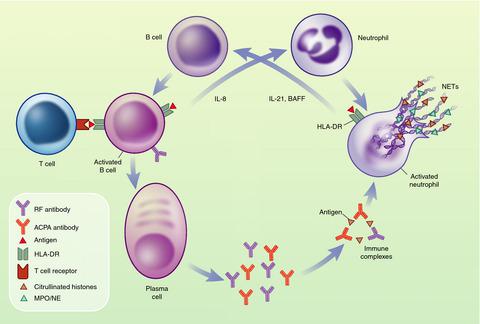当前位置:
X-MOL 学术
›
Immunology
›
论文详情
Our official English website, www.x-mol.net, welcomes your
feedback! (Note: you will need to create a separate account there.)
Crosstalk between B cells and neutrophils in rheumatoid arthritis
Immunology ( IF 4.9 ) Pub Date : 2021-09-03 , DOI: 10.1111/imm.13412 Utsa Karmakar 1 , Sonja Vermeren 1
Immunology ( IF 4.9 ) Pub Date : 2021-09-03 , DOI: 10.1111/imm.13412 Utsa Karmakar 1 , Sonja Vermeren 1
Affiliation

|
Rheumatoid arthritis (RA) is a chronic, systemic autoimmune disease without known cure that primarily affects synovial joints. RA has a prevalence of approximately 1% of the population worldwide. A vicious circle between two critical immune cell types, B cells and neutrophils, develops and promotes disease. Pathogenic anti-citrullinated protein antibodies (ACPA) directed against a range of citrullinated epitopes are abundant in both plasma and synovial fluid of RA patients. In addition to stimulating numerous cell types, ACPA and other autoantibodies, notably rheumatoid factor, form immune complexes (ICs) that potently activate neutrophils. Attracted to the synovium by abundant chemokines, neutrophils are locally stimulated by ICs. They generate cytokines and release cytotoxic compounds including neutrophil extracellular traps (NETs), strands of decondensed chromatin decorated with citrullinated histones and granule-derived neutrophil proteins, which are particularly abundant in the synovial fluid. In this way, neutrophils generate citrullinated epitopes and release peptidylarginine deiminase (PAD) enzymes capable of citrullinating extracellular proteins in the rheumatic joint, contributing to renewed ACPA generation. This review article focusses on the central function of citrullination, a post-translational modification of arginine residues in RA. The discussion includes ACPA and related autoantibodies, somatic hypermutation-mediated escape from negative selection by autoreactive B cells, promotion of the dominance of citrullinated antigens by genetic and lifestyle susceptibility factors and the vicious circle between ACPA-producing pathogenic B cells and NET-producing neutrophils in RA.
中文翻译:

类风湿性关节炎中 B 细胞和中性粒细胞之间的串扰
类风湿性关节炎 (RA) 是一种主要影响滑膜关节的慢性、全身性自身免疫性疾病,尚无已知治愈方法。RA 的患病率约为全球人口的 1%。B 细胞和中性粒细胞这两种关键免疫细胞类型之间的恶性循环会发展和促进疾病。针对一系列瓜氨酸化表位的致病性抗瓜氨酸化蛋白抗体 (ACPA) 在 RA 患者的血浆和滑液中含量丰富。除了刺激多种细胞类型外,ACPA 和其他自身抗体,尤其是类风湿因子,还会形成有效激活中性粒细胞的免疫复合物 (IC)。中性粒细胞被丰富的趋化因子吸引到滑膜,被 IC 局部刺激。它们产生细胞因子并释放细胞毒性化合物,包括中性粒细胞胞外陷阱 (NET),用瓜氨酸组蛋白和颗粒衍生的中性粒细胞蛋白装饰的解聚染色质链,这些蛋白在滑液中特别丰富。通过这种方式,中性粒细胞产生瓜氨酸化表位并释放能够在风湿性关节中瓜氨酸化胞外蛋白的肽基精氨酸脱亚胺酶 (PAD),从而促进 ACPA 的产生。这篇综述文章重点关注瓜氨酸化的核心功能,这是 RA 中精氨酸残基的翻译后修饰。讨论包括 ACPA 和相关自身抗体、体细胞超突变介导的自身反应性 B 细胞的负选择逃避,
更新日期:2021-11-04
中文翻译:

类风湿性关节炎中 B 细胞和中性粒细胞之间的串扰
类风湿性关节炎 (RA) 是一种主要影响滑膜关节的慢性、全身性自身免疫性疾病,尚无已知治愈方法。RA 的患病率约为全球人口的 1%。B 细胞和中性粒细胞这两种关键免疫细胞类型之间的恶性循环会发展和促进疾病。针对一系列瓜氨酸化表位的致病性抗瓜氨酸化蛋白抗体 (ACPA) 在 RA 患者的血浆和滑液中含量丰富。除了刺激多种细胞类型外,ACPA 和其他自身抗体,尤其是类风湿因子,还会形成有效激活中性粒细胞的免疫复合物 (IC)。中性粒细胞被丰富的趋化因子吸引到滑膜,被 IC 局部刺激。它们产生细胞因子并释放细胞毒性化合物,包括中性粒细胞胞外陷阱 (NET),用瓜氨酸组蛋白和颗粒衍生的中性粒细胞蛋白装饰的解聚染色质链,这些蛋白在滑液中特别丰富。通过这种方式,中性粒细胞产生瓜氨酸化表位并释放能够在风湿性关节中瓜氨酸化胞外蛋白的肽基精氨酸脱亚胺酶 (PAD),从而促进 ACPA 的产生。这篇综述文章重点关注瓜氨酸化的核心功能,这是 RA 中精氨酸残基的翻译后修饰。讨论包括 ACPA 和相关自身抗体、体细胞超突变介导的自身反应性 B 细胞的负选择逃避,











































 京公网安备 11010802027423号
京公网安备 11010802027423号